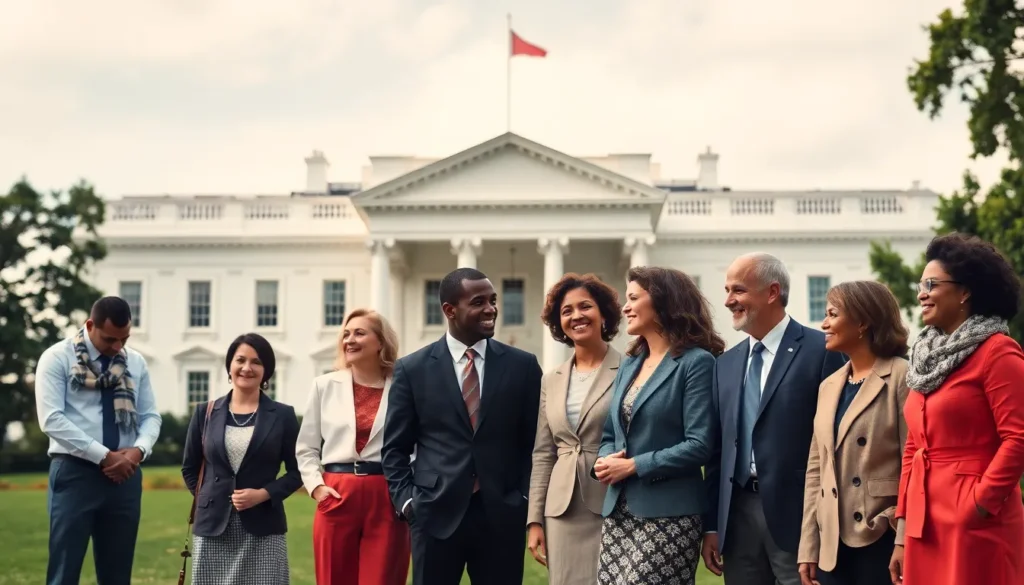Ever wondered how many vice presidents have graced the halls of the White House? It’s a number that might surprise you. While the presidency often steals the spotlight, the vice presidency is like the trusty sidekick in a superhero movie—often overlooked but essential to the plot.
Table of Contents
ToggleOverview of Vice Presidents in the U.S.
The United States has had a total of 49 vice presidents since the office was established in 1789. Each vice president’s role has evolved over time, shaping the office’s significance in U.S. governance. Although initially seen as a backup for the president, the position has gained prominence.
Vice presidents often step into critical roles during presidential transitions, acting as key advisors and decision-makers. They typically preside over the Senate, casting tie-breaking votes when necessary. Some vice presidents have succeeded to the presidency, demonstrating the importance of their position.
Notably, John Adams served as the first vice president and later became the second president. The longest-serving vice president, Joe Biden, held office from 2009 to 2017 before assuming the presidency in 2021. The current vice president, Kamala Harris, became the first woman and first person of South Asian and African American descent to hold the office.
Several vice presidents, including Al Gore and Dick Cheney, left significant marks on policy and administration. More recent precedents show active involvement in political affairs, influencing legislative agendas and international relations. Serving under different administrations, vice presidents adapt strategies to align with the president’s goals.
As of now, understanding the total number of vice presidents brings insight into the evolution of U.S. leadership. The historical context reveals the important interplay between the president and vice president. This search for knowledge highlights both the challenges and triumphs experienced by those holding the office of vice president.
Total Number of Vice Presidents

The U.S. has seen 49 individuals serve as vice president since 1789. This office has witnessed significant changes over the years in both its role and influence.
Historical Context
The vice presidency’s history began with John Adams, the first vice president under George Washington. Initially viewed as a minor position, the role gained importance over time as vice presidents stepped into significant responsibilities. Figures like Thomas Jefferson and John C. Calhoun contributed to the evolving perception of the office. The responsibilities expanded further with the advent of modern governance, as vice presidents began efficiently engaging in domestic and foreign policy discussions.
Timeline of Vice Presidents
The timeline of vice presidents illustrates key milestones in the office’s history. Starting from John Adams in 1789, the vice presidency saw notable figures like Aaron Burr and Chester A. Arthur. Millard Fillmore served after Zachary Taylor’s death in 1850. Recent vice presidents include Al Gore, who served from 1993 to 2001, and Joe Biden, who held office from 2009 to 2017. Kamala Harris, the current vice president since 2021, represents a significant milestone as the first woman and first person of South Asian and African American descent in the role.
Notable Vice Presidents in History
The vice presidency has hosted influential figures throughout U.S. history, shaping politics and governance significantly.
Early Vice Presidents
John Adams, the first vice president, set a precedent for the role in 1789. Aaron Burr made headlines for his contentious duel with Alexander Hamilton in 1804. Thomas Jefferson’s vice presidency, alongside Adams, highlighted the growing political rivalry. Martin Van Buren played a notable role during the Jacksonian era, helping to define party politics. These early vice presidents often filled gaps in leadership, providing stability in turbulent times.
Modern Vice Presidents
Al Gore emphasized environmental issues during his tenure from 1993 to 2001, advocating for climate change awareness. Joe Biden’s eight years in office focused on foreign policy and domestic affairs, enhancing the vice presidency’s influence. Kamala Harris, the first female vice president, represents a significant milestone in U.S. history, working on issues like immigration and economic justice. Each modern vice president has expanded the office’s impact, engaging actively in legislative processes and political discourse.
Roles and Responsibilities of Vice Presidents
Vice presidents play crucial roles by supporting the president and engaging in governance. Over time, their responsibilities have significantly expanded.
Constitutional Duties
Constitutionally, the vice president serves as the president of the Senate, casting tie-breaking votes when necessary. Their role includes counting electoral votes during presidential elections. Beyond these duties, the vice president stands ready to assume the presidency if the current president cannot fulfill their duties. This foundational responsibility ensures continuity in government. Although often viewed as a backup, the vice president’s constitutional functions are essential for the legislative process and the administration’s overall stability.
Evolving Responsibilities
Responsibilities for vice presidents have evolved significantly since the office’s inception. They now often participate actively in policy discussions and represent the president on domestic and foreign issues. Recent vice presidents have taken on specific portfolios, such as climate change or health care. This shift reflects a broader expectation for vice presidents to contribute meaningfully to governance. Kamala Harris, for example, addresses immigration and economic justice issues, showcasing the modern vice president’s growing influence in shaping policies that affect millions.
The journey of the vice presidency reflects a significant evolution in American governance. With 49 individuals having served in this pivotal role since 1789, the vice presidency has transformed from a mere backup position to a vital component of the executive branch. Each vice president has left a unique mark on the office, influencing both domestic and foreign policies.
As the current vice president Kamala Harris continues to break new ground, the legacy of those before her underscores the importance of this role in shaping the nation’s political landscape. The vice presidency remains an essential part of the U.S. government, ensuring stability and continuity while adapting to the changing demands of leadership.





